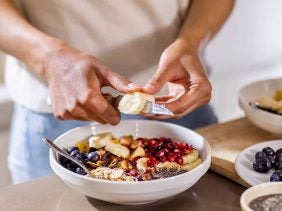9 Unhealthy Foods You Should Avoid
 ©d3sign
©d3sign
Take a stroll through the supermarket aisles nowadays, and you’ll be faced with an unbelievable array of foods. Between the boxes with bright logos and the plastic packages crinkling in your face, all of them boasting some nutritional claim or other – it’s not that easy to make health-conscious choices. While the front claims “low sugar” or “light,” the ingredient lists on the back are stuffed with words you can hardly read. So, which of these so-called health claims is for real, and which should you leave behind on the shelf? We’ll show you the unhealthy foods to watch out for, and some smarter choices.
Editor’s Note: Balanced nutrition can and should be flexible. If you are conscious of what you’re eating, and take it into account with the rest of your diet, there can be a place for any food you want. In this article, we’re rounding up some of the sneaky hidden culprits. You’re best off not combining all of these at once.
Our List of Unhealthy Foods
We’ve made you up a list of the unhealthy foods that you’re better off avoiding if you’re aiming for a balanced diet. And just to make sure you won’t be missing out on any of the flavors, we’ve also paired each one with a healthier alternative.
#1 Frozen Convenience Food
It’s no secret that fast food often features in unhealthy foods lists. But fast food is more than just the paper bags from the drive-through. Premade meals from the freezer aisle are also fast foods in their own way. They’re easy to access and can be made with minimal effort. They come from a package or a bag, and after a quick stint in the oven or microwave, they land on your table, ready to eat. It sounds too good to be true – and oftentimes, it is. Frozen convenience foods often have lots of fat, lots of calories, and artificial additives.
The healthier alternative takes more time, but gives you control over your macros. Buy fresh and cook it yourself. Make a pizza with nearly as little effort as the frozen kind, thanks to our Protein Pizza mix: Take this recipe for Protein Pizza Bianca, for example.
We’re not saying to swear off all frozen foods. Frozen fruit and veg can be a great time-saver. But leave the frozen meals in the supermarket.
#2 Bread and Rolls with White Flour
It’s the weekend and you’re ready for a leisurely breakfast! Obviously, bread is on the menu. Your best choice here? Whole-grain products. Bread and rolls made with white flour do nothing but flood your blood with simple carbs. These unhealthy foods lack the fiber or other helpful nutrients to keep you full and energized after your blood sugar crashes back down a couple of hours later.
What should you do? Bake it yourself! Instead of getting a frozen or half-baked package of rolls, why not try our Protein Bread mix on a lazy Sunday?
The same applies to other flour-based products, by the way. Pasta and couscous made with simple carbs don’t stick around in your system for long. Try whole-grain or spelt pasta (or our Protein Pasta), and switch your couscous out for quinoa.
#3 Cold Cuts and Salami
You might be used to seeing a slice of ham slapped between two slices of white bread with a bit of butter or mayo and having that count as a sandwich. We’ve already covered the bread. But how about the processed packaged meat?
Several studies have shown a connection between high consumption of red and processed meat (such as grilled meat, sausages, and cold cuts) and cancer – particularly lung, esophageal, and colon cancers. On top of that, meat can increase your chances of heart and circulatory disease. And the World Health Organization has officially classified red meat and processed meat as carcinogenic. The NHS agrees: Cut down your red and processed meat intake.
Looking for alternatives for your cold cuts? They’re sitting there in the refrigerated section, just a stone’s throw away from the unhealthy foods you’re looking at right now. The past few years have seen a huge uptick in plant-based slices, both vegetarian and vegan. The same rule of thumb still applies: Read the list of ingredients and go for a product that’s made up of as few things as possible. The more of those ingredients you know and recognize, the better.
#4 Sweet Pastries
Watch out in the bakery. Those sweets are lurking around every corner, calling out for you to sweep them away from their misery in a crinkling little bag. From croissants to pain au chocolat, cakes and muffins, cinnamon rolls or donuts: the list of sweet unhealthy foods is endless. What do they all have in common? Unreal quantities of fat and sugar. And this particular combination is not great for your health.
Just because you’re not treating yourself to the cookies or the pasteis de nata doesn’t mean you have to swear off all sweets, though! It’s never been easier to make your own tempting treats at home. What do you think of the moistest brownies, sugar-free vegan waffles, or some vegan protein cookie dough?
#5 Muesli, Granola, and Cereal
“With Whole Grains!” “Less Sugar!” “Added Fiber!” Sounds familiar, right? We see claims like these on the front of what feels like every package of breakfast cereal these days. It can be misleading! Breakfast cereals are mostly made up of processed grains like wheat, oats, rice, and corn. Flip it over and read the ingredient list to see how healthy that bowl of crunchies really is. If the ingredients include glucose or any kind of fructose-containing syrup, put the box down and try one of our amazing alternatives to those unhealthy foods.
You hadn’t forgotten, had you? We have Protein Muesli so pick one up and you’ll never go back to the crispies. And each of our options fits the criteria for a balanced diet.
Can’t imagine swearing off the O’s? Incorporate those calories into your nutrition plan and make changes elsewhere. We want you to feel good about being healthy. Not guilty.
#6 Light Products
Anything that has “light” on the label must have at least 30 percent fewer calories, carbs, fat, sugar, or alcohol. That sounds promising, sure. But it isn’t. Remember, there are different kinds of light products. Some of them reduce the fat content, and replace the flavor by putting in more sugar. Others take sugar out and pump in low-calorie sweeteners. What they all have in common: the taste and texture suffers. In Germany, the German Nutrition Society is no longer recommending people opt for reduced-fat light products.
Not sure where to start? The NHS has a helpful page explaining which terms are and are not allowed in UK food labeling. Bonus: It walks you through how to weed out the useful information from the sneaky pseudo-claims.
#7 Chips and Fries
Potatoes are everywhere. From wedges dipped in mayo to a handful of ketchup-drenched fries, right through to a bag packed with salt-and-vinegar crunchiness. But all of these options, sadly, can also be bad for your health. There are two main reasons behind this. For one thing, the high fat and salt content can influence your cardiovascular system. And the second reason: fried products like fries and chips contain acrylamide. This chemical forms in starchy foods at high temperatures, and it’s one of the factors attributed to their appealing aroma. That’s as may be – but acrylamide may increase the risk of developing cancer. So put the chips back.
#8 Packaged Salad Dressings
There’s nothing fresher than a head of salad, topped with tomatoes, cucumber, and carrots. Toss a few chickpeas on top, maybe a few feta crumbles or nuts… now the only thing missing is a few glugs of dressing! Think again. It’s true that you can’t go wrong with veg and protein sources for your salad. But a dressing out of a bottle from the supermarket can negate all your best intentions. That Thousand Island dressing? Made from mayo and ketchup. Caesar dressing? Parmesan cheese, oil, and eggs.
Keeping your salad totally healthy is as easy as mixing your own dressing yourself. Whisk up a mix of an aromatic vinegar, a good olive oil, a bit of mustard and honey, maybe a few herbs, salt and pepper? It’s got fewer calories and it tastes amazing. Nothing better.
#9 Juices and Smoothies
Let’s get this out there first: juices and smoothies aren’t unhealthy in and of themselves. Cold-pressed juices retain tons of their vitamins, and smoothies deliver fiber on top of that. Still: Only enjoy juices and smoothies in moderation. Along with those helpful nutrients, they’re also jam-packed with fructose, otherwise known as fruit sugar.
Can’t imagine getting your vitamins any other way? We’ve done the work for you. Our vegetarian Daily Vitamins have extracted the best out of German fruits and veg and packed them into capsule form. Two a day will cover many of your nutritional needs. Do consult a doctor before starting with supplements if you aren’t sure where your body is currently at.
Unhealthy Foods: Conclusion
If you’re aiming for a balanced diet, enjoy any of the foods we’ve mentioned above in moderation. And it’s not just us saying that. The NHS also includes some of the above suggestions in its 8 tips for healthy eating. So: Pick whole grains, reduce your meat intake, and cut out added sugar and salt where you can. But don’t take all the pleasure out of eating. If your diet adds calories or fat from one source, reduce them from another. Change it up as often as you like. The takeaway is, as always: Balance is key!
More healthy living tips from foodspring:
- High-protein vegan foods to keep you on your Veganuary game
- Calorie Cheat Sheet: Our (Printable) Guide to Help You Track Calories
- What are Macros? Learn more about the nutrients your body needs
Sources for this article
We at foodspring use only high-quality sources, including peer-reviewed studies, to support the facts within our articles. Read our editorial policy to learn more about how we fact-check and keep our content accurate, reliable, and trustworthy.
- (1) https://pubmed.ncbi.nlm.nih.gov/26633248/
- (2) https://www.nhs.uk/live-well/eat-well/red-meat-and-the-risk-of-bowel-cancer/
- (3) https://www.dge.de/ernaehrungspraxis/vollwertige-ernaehrung/10-regeln-der-dge/
- (4) https://www.nhs.uk/live-well/eat-well/food-labelling-terms/
































